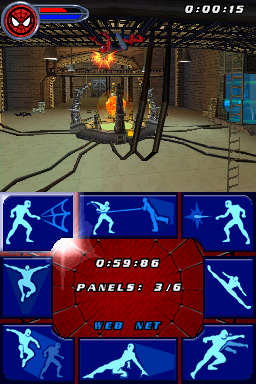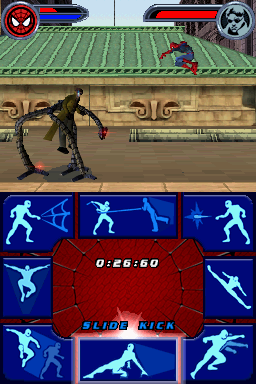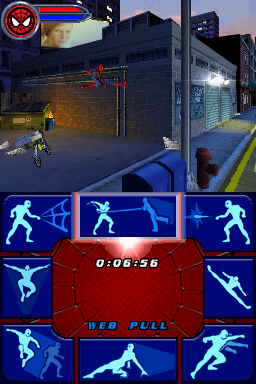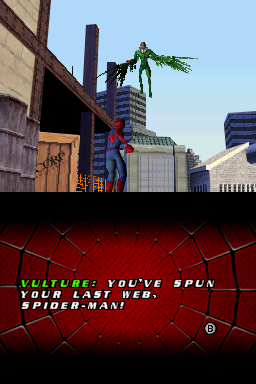Over the holidays, GDNet swapped some emails with Karthik Bala, one of the co-founders of Vicarious Visions. Karthik shared details about the design and development of Spider-Man 2, what it was like developing software for a hardware platform that was still in the works, and offered some advice to new developers.
[size="3"]First off, can you give us some vital statistics about the Spider-Man 2 development:
- [size="3"]Team size (# of programmers, # of artists, and so on)
- [size="3"]Budget size
- [size="3"]Length of development
Karthik: We roughly had about 6 months in total for development. The first month was spent in R&D on the hardware and the remaining 5 months in development of the game. The team grew to about 25 people at its peak - which is quite large for a handheld team. There were 11 engineers, 10 artists, 3 designers and 1 project manager. Unfortunately, I can't disclose the budget. Suffice it say it was more expensive than any GBA title we've ever done.
[size="3"]Can you give us an overview of the design process for Spider-Man 2? Was it difficult to tailor the game to the Nintendo DS's unique features, especially the dual screens and the touch screen?
Karthik: Initially it was very challenging because during the first few months of development, the hardware itself was a big circuit board with an LCD! This is to be expected as the hardware is in development. But without a final form factor in your hands, it's hard to get the controls/design just right. In addition, developing for a touch screen/dual screen system meant that we were moving into some uncharted waters in terms of game design. It was a lot of fun and nerve wracking at the same time!
Luckily, we had a really great team working on the project who seem to thrive on doing launch titles. Our approach to design was to create a game that built on top of the established mechanics of what we created on Spider-Man: Mysterio's Menace GBA, push the 3D graphical capabilities of the system and use the touch screen in a compelling and meaningful way in the core game play.
[font="arial, verdana, tahoma, sans-serif"][size="2"][/font]
[size="3"]In the same vein, did you have any issues with the hardware or software specifications for the DS changing over the course of the development?
Karthik: Sure. There's all sorts of changes that go on during the course of any hardware development. Fortunately, Nintendo had a very clear vision on where they were taking the hardware. So that helped us a lot. But for several months, we only had development systems that had a single screen and eventually it became a touch screen. It wasn't until E3 that we saw what the form factor would be like. It wasn't until half way through the project that we were able to even hold a DS to get a feel for the game. However, I think we made some good design and engineering decisions early on that seemed to have paid off.
[size="3"]You have a lot of experience developing titles for the various Nintendo Game Boy models. Were you able to leverage that experience, and any tools and processes you may have created for past projects? Or did you have to create new ones? Was adapting difficult?
Karthik: It was definitely a mix of both. Our team was comprised of both GBA and console experts. Much of our technology from GBA as well as our Vicarious Visions Alchemy middleware tools were synthesized to create a very powerful DS game engine. There were certainly a lot of new technology developed that really took advantage of the hardware. For example, we're particularly proud of our animation system. It allowed Spidey to have more than 4000 frames of animation and Doc Ock's complex rig had over 160 bones. That's a lot for even a console game and we were able to maintain a solid 60fps in-game.
The project was definitely a challenge for us - mostly because of the short development schedule. However, Nintendo designed a very well balanced piece of hardware, which made it a lot of fun to work on.
[font="arial, verdana, tahoma, sans-serif"][size="2"][/font]
[size="3"]The reviews of Spider-Man 2 that I have read have been quite positive, especially about how you tailored the game to the DS. Were you tempted to tap into the DS's wireless capabilities?
Karthik: You bet. But with everything we were doing with the game already, it was deemed early on that to add wireless would be too high risk. So that feature fell on the cutting room floor. However, we feel that wireless multiplayer is a key component of what the DS has to offer so you'll be seeing that in our future games.
[size="3"]Are you working on any other Nintendo DS titles (that you can talk about)?
Karthik: We can't really talk specifically about any other titles right now, but we do have several new projects in development.
[size="3"]Over the past few years, VV has focused on developing brands more than creating new properties of their own. Do you think this will continue?
Karthik: I think so. One of the harsh realities of the game industry right now is that it's all about big established brands for mass market consumers. Cost of development has risen so much in the last few years and this will continue to be the case for the next generation of consoles and handhelds. DS and PSP games cost more than GBA and consumer expectations continue to rise. So it's difficult for publishers to greenlight a lot of new original properties as a result. VV has really specialized in working with top entertainment brands and we're having a lot of fun with that! So I think that trend will continue for the foreseeable future.
[font="arial, verdana, tahoma, sans-serif"][size="2"][/font]
[size="3"]VV has created games on a huge number of platforms: personal computers, consoles, handhelds, and cellphones. How important has your crossplatform expertise been in your success as a company?
Karthik: Multiplatform expertise has been important for us for a very long time. And that will continue. However, with so many new platforms emerging (especially with lots of new mobile devices) we can't possibly span them all. So we'll be focusing our efforts on a fewer number of platforms and developing titles that really showcase the hardware and create compelling experiences for players.
[size="3"]VV has it's roots in the "starving artist" indie scene, and even won awards in the 1st Indie Games Festival at GDC in 1999. Now VV has become more a "industry standard" independent (i.e., a development shop unowned by a publisher). Do you miss your startup days at all?
Karthik: Well, thank you very much! It certainly has been a wild ride to date. My brother and I started VV as a hobby when we were in high school. It was incorporated while we were in college when we got our first publishing deal. And this year we celebrated our 10th anniversary. In some respects I do miss the startup days quite a bit. But as some of our guys have pointed out to me, the "good old days" were often the "bad old days". We faced a lot of challenges as starving artists back in the day and now it's a very different kind of challenge. It's still hard work (it never gets easier), but we're glad that we're making games that millions of people enjoy, rather than the 10 that bought our first game!
[size="3"]Do you have any advice to give to developers who might be thinking of creating their own independent development shops?
Karthik: I'm sure a book could be written on everything not to do. Just don't be afraid of making mistakes and giving it a try. It's going to be hard. And quite honestly, I think it's much harder to start up a game company these days than it once used to be. But at the same time, the industry is bigger now with lots of opportunities that were never there before. You may not work on the next big console blockbuster right away, but there are a lot of smaller opportunities out there (cellphones, web-based, handheld etc.). Focus on quality, building your skills and a great team. And don't give up. It will work out.
[font="arial, verdana, tahoma, sans-serif"][size="2"][/font][font="arial, verdana, tahoma, sans-serif"] [/font]





